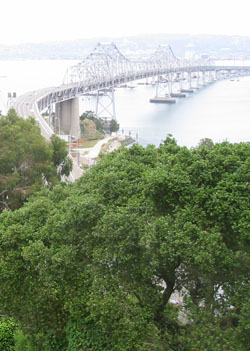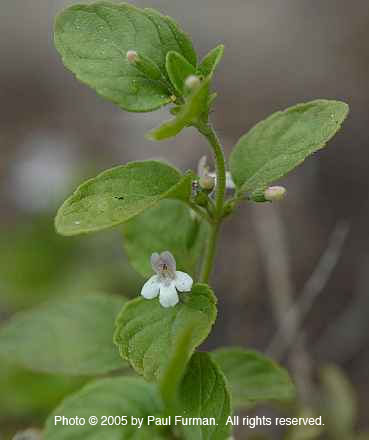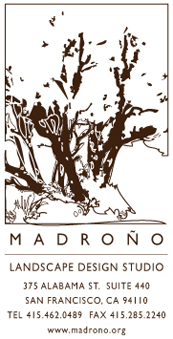
Distant rumblings from city hall portend a boom on Treasure Island, the former Navy base on the brink of becoming San Francisco's newest residential neighborhood. This exercise of urban planning in the middle of the bay will be a closely watched experiment. Early drafts of the master plan have called for sustainable design and green building development, for example, including an open space and landscaping component that emphasizes the use of locally native plants.
No plant is native to Treasure Island -- this 400-acre landmass was built of quarried rock and bay-dredged landfill in the late 1930s. But the first seawalls for that project were raised from the northern shoals of Yerba Buena Island, the natural island now joined with man-made Treasure Island like a siamese twin. And the steep slopes of Yerba Buena Island, though radically altered by invasive weeds and the hand of man, still harbor remnants of the original native flora, a population from which the landscape planners may wish to draw their inspiration.
Consider the coast red elderberry (Sambucus racemosa var. racemosa), enthusiastic seeder of moist forest margins, a proven survivor even in the deepening shadows of eucalyptus and monterey pine. This robust deciduous shrub can reach tree-like heights of 15-20 feet, filling the middle space beneath a taller canopy with a cheerful bloom of frothy white blossoms from March through July. Just now the fruit has begun to form, dramatic clusters of scarlet berries adored by birds. After the leaves drop in late fall, the bare elderberry still holds interest for its branches, which have a large pith and are easily hollowed out. The Ohlone used these twigs for flutes, whistles, and clapper sticks (a drum alternative); indeed, the genus name Sambucus pays homage to the Greek sambuke, a musical instrument made from elder wood. Excellent as a specimen plant in the garden or as a focal point in an urban park, and a tasteful alternative to cotoneaster, the coast red elderberry should rank high on anybody's landscaping wish list.
 The island was named Yerba Buena (Spanish for "good herb") after the creeping wild mint, Satureja douglasii, that once covered these shores. While ivy, broom, and poison hemlock have now overrun much of the understory, to the detriment of this plant which grows no more than one inch tall, dedicated seekers may still discover patches of yerba buena in the shaded woods. Keep an eye out for for the slender, purplish prostrate stems rooting at the nodes, with pairs of delicate light-green oval-shaped leaves that smell wonderful when crushed between the fingers. Yerba buena looks delightful in the garden when trailing over a stone retaining wall or other hardscaping, and can soften the spaces between paving stones or beside paths. Tea made from yerba buena is also widely hailed for its curative properties.
Perhaps this medicinal influence has kept the island of Yerba Buena so healthy so long in the face of mankind's meddling. Throughout the late 19th century, for example, herds of goats were raised here for meat (the island was officially called "Goat Island" from 1895-1931), a steady and strong disturbance to the original flora. The efficiency of the goat as eating machine was amply demonstrated last March, when a herd of 250 goats were brought to the island as "organic weed abatement" in a project to reduce fire hazard. The good news is that the goats successfully removed the problem plants from the target area; the bad news is that the goats in fact removed every plant from the target area. A goat does not distinguish between a native and a weed when mowing down everything in sight. Any habitat thus grazed to the ground will not simply revert to its native state, but rather becomes more vulnerable to invasion by exotics. The goat as weed control mechanism is, at best, a short-term solution.
But even the destructive capacity of goats cannot match the record of the U.S. military. The list of environmental cleanup projects currently under Navy command here covers more than 30 sites, including the wastewater sludge disposal area on Yerba Buena's eastern point and the gasoline tank farm on its northwestern flank, with a potent cocktail of pollutants now on the island including lead and other heavy metals, pesticides, asbestos, petroleum hydrocarbons, and "volatile organic compounds" (a plausible nickname for goats). The survival of any native plants here at all under such adverse conditions testifies to their remarkable powers of endurance.
Native plants help to compose the special identity of place, a sense of belonging to a greater order, a connection that is slowly being lost. A redeveloped Treasure Island, if landscaped with selections from the local native flora, will reconnect its residents to the past while pursuing a sustainable future, bridging the natural and the urban. Such healthy intersections of the wildland and the city are perhaps the greatest treasures of all.
* * *
Geoffrey Coffey is a freelance writer for the San Francisco Chronicle and the founder of the Madroño landscape design studio. He chairs the board of Native Spaces, a non-profit organization promoting the use of native plants in the built landscape.
The island was named Yerba Buena (Spanish for "good herb") after the creeping wild mint, Satureja douglasii, that once covered these shores. While ivy, broom, and poison hemlock have now overrun much of the understory, to the detriment of this plant which grows no more than one inch tall, dedicated seekers may still discover patches of yerba buena in the shaded woods. Keep an eye out for for the slender, purplish prostrate stems rooting at the nodes, with pairs of delicate light-green oval-shaped leaves that smell wonderful when crushed between the fingers. Yerba buena looks delightful in the garden when trailing over a stone retaining wall or other hardscaping, and can soften the spaces between paving stones or beside paths. Tea made from yerba buena is also widely hailed for its curative properties.
Perhaps this medicinal influence has kept the island of Yerba Buena so healthy so long in the face of mankind's meddling. Throughout the late 19th century, for example, herds of goats were raised here for meat (the island was officially called "Goat Island" from 1895-1931), a steady and strong disturbance to the original flora. The efficiency of the goat as eating machine was amply demonstrated last March, when a herd of 250 goats were brought to the island as "organic weed abatement" in a project to reduce fire hazard. The good news is that the goats successfully removed the problem plants from the target area; the bad news is that the goats in fact removed every plant from the target area. A goat does not distinguish between a native and a weed when mowing down everything in sight. Any habitat thus grazed to the ground will not simply revert to its native state, but rather becomes more vulnerable to invasion by exotics. The goat as weed control mechanism is, at best, a short-term solution.
But even the destructive capacity of goats cannot match the record of the U.S. military. The list of environmental cleanup projects currently under Navy command here covers more than 30 sites, including the wastewater sludge disposal area on Yerba Buena's eastern point and the gasoline tank farm on its northwestern flank, with a potent cocktail of pollutants now on the island including lead and other heavy metals, pesticides, asbestos, petroleum hydrocarbons, and "volatile organic compounds" (a plausible nickname for goats). The survival of any native plants here at all under such adverse conditions testifies to their remarkable powers of endurance.
Native plants help to compose the special identity of place, a sense of belonging to a greater order, a connection that is slowly being lost. A redeveloped Treasure Island, if landscaped with selections from the local native flora, will reconnect its residents to the past while pursuing a sustainable future, bridging the natural and the urban. Such healthy intersections of the wildland and the city are perhaps the greatest treasures of all.
* * *
Geoffrey Coffey is a freelance writer for the San Francisco Chronicle and the founder of the Madroño landscape design studio. He chairs the board of Native Spaces, a non-profit organization promoting the use of native plants in the built landscape.

